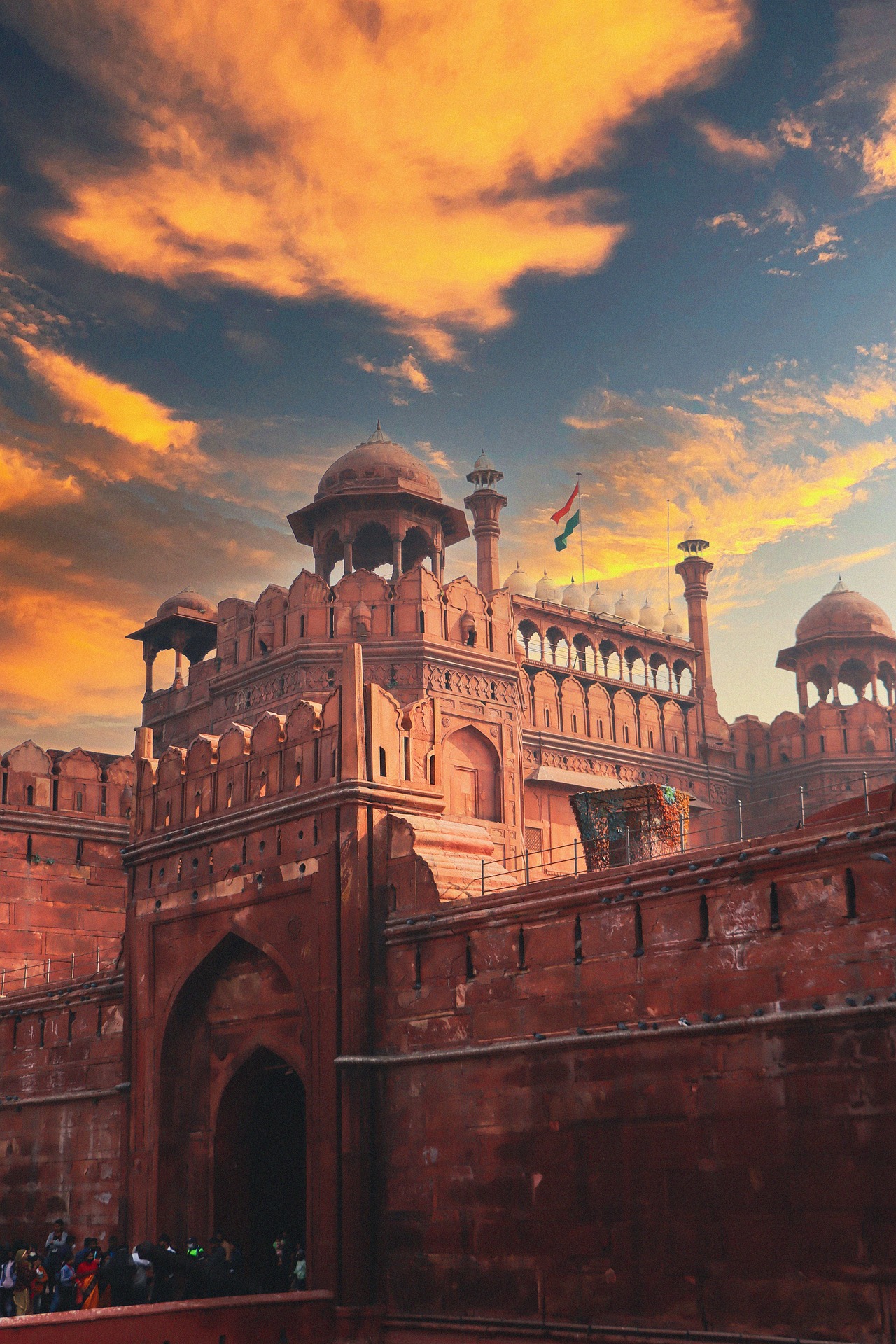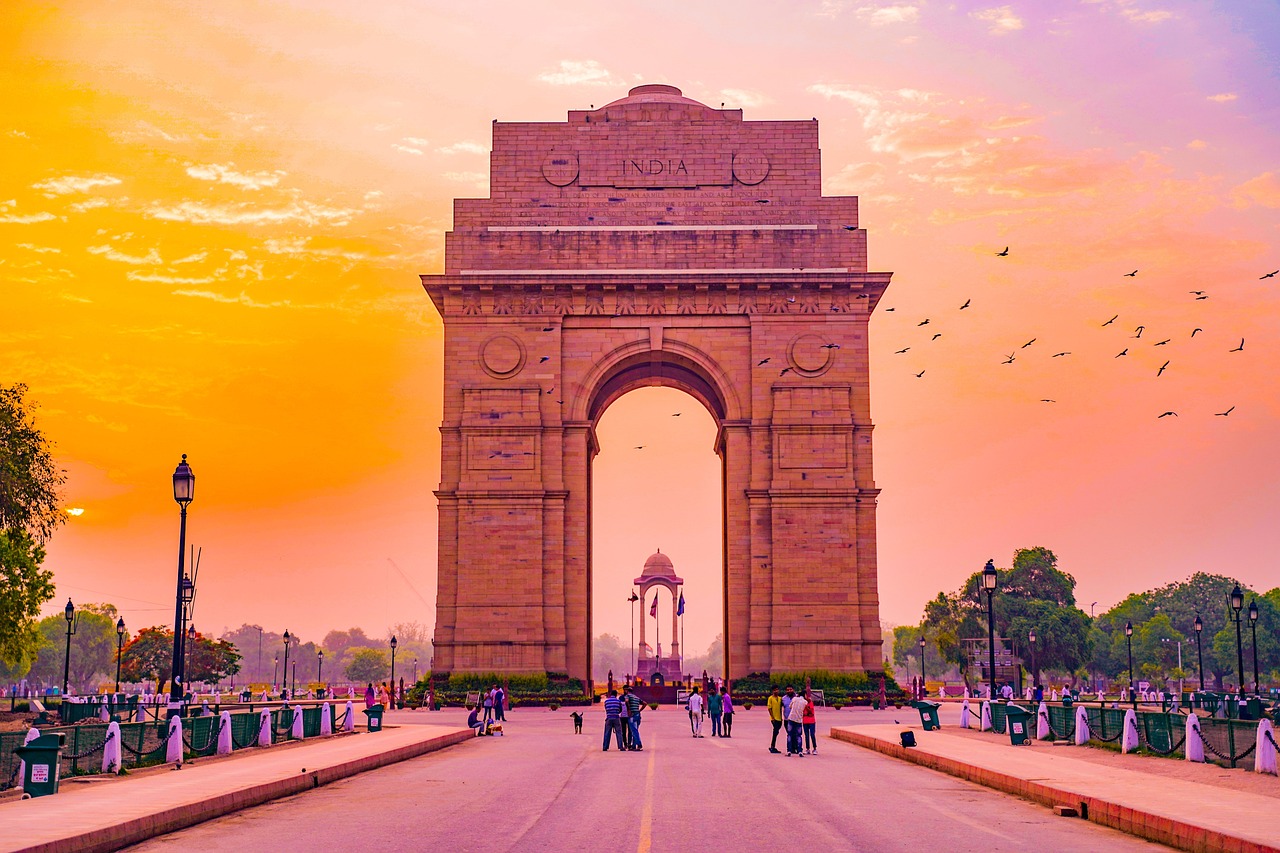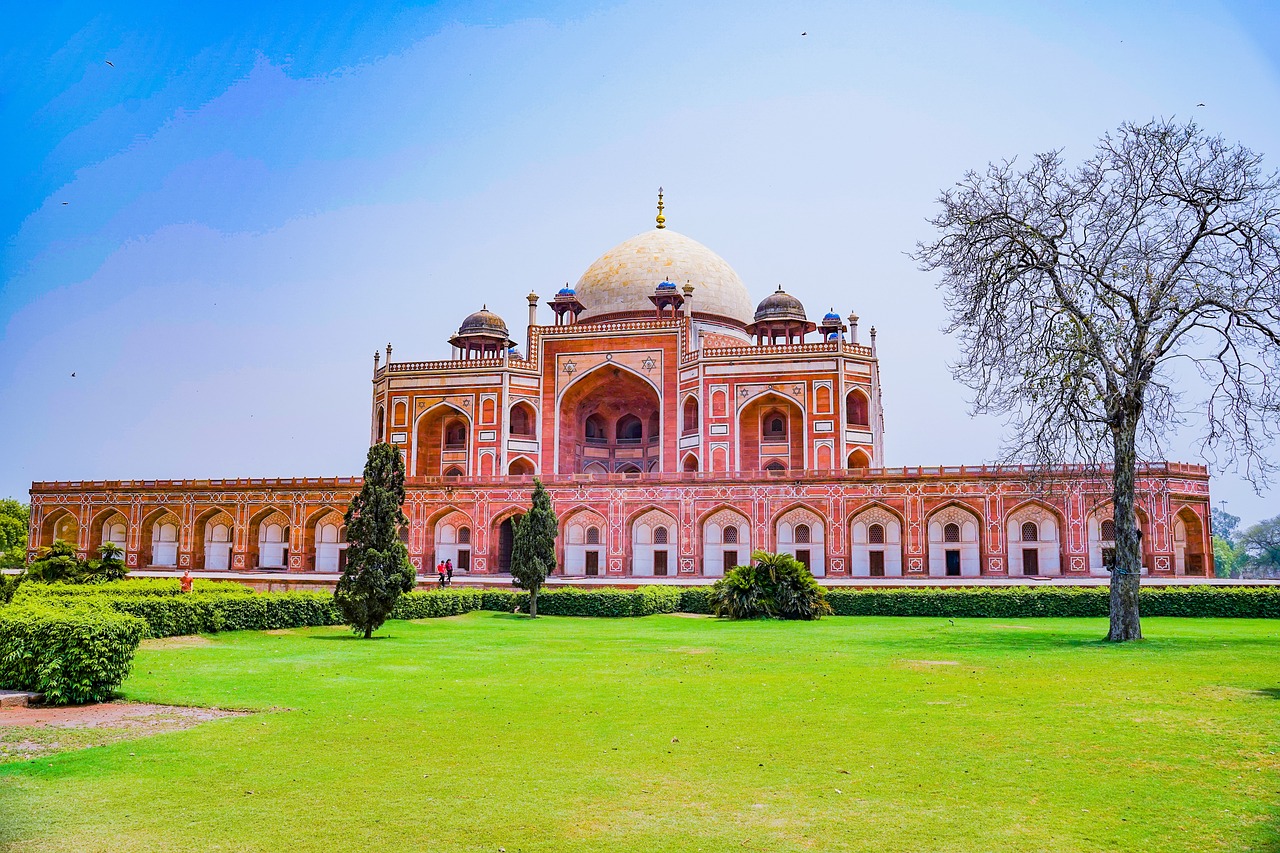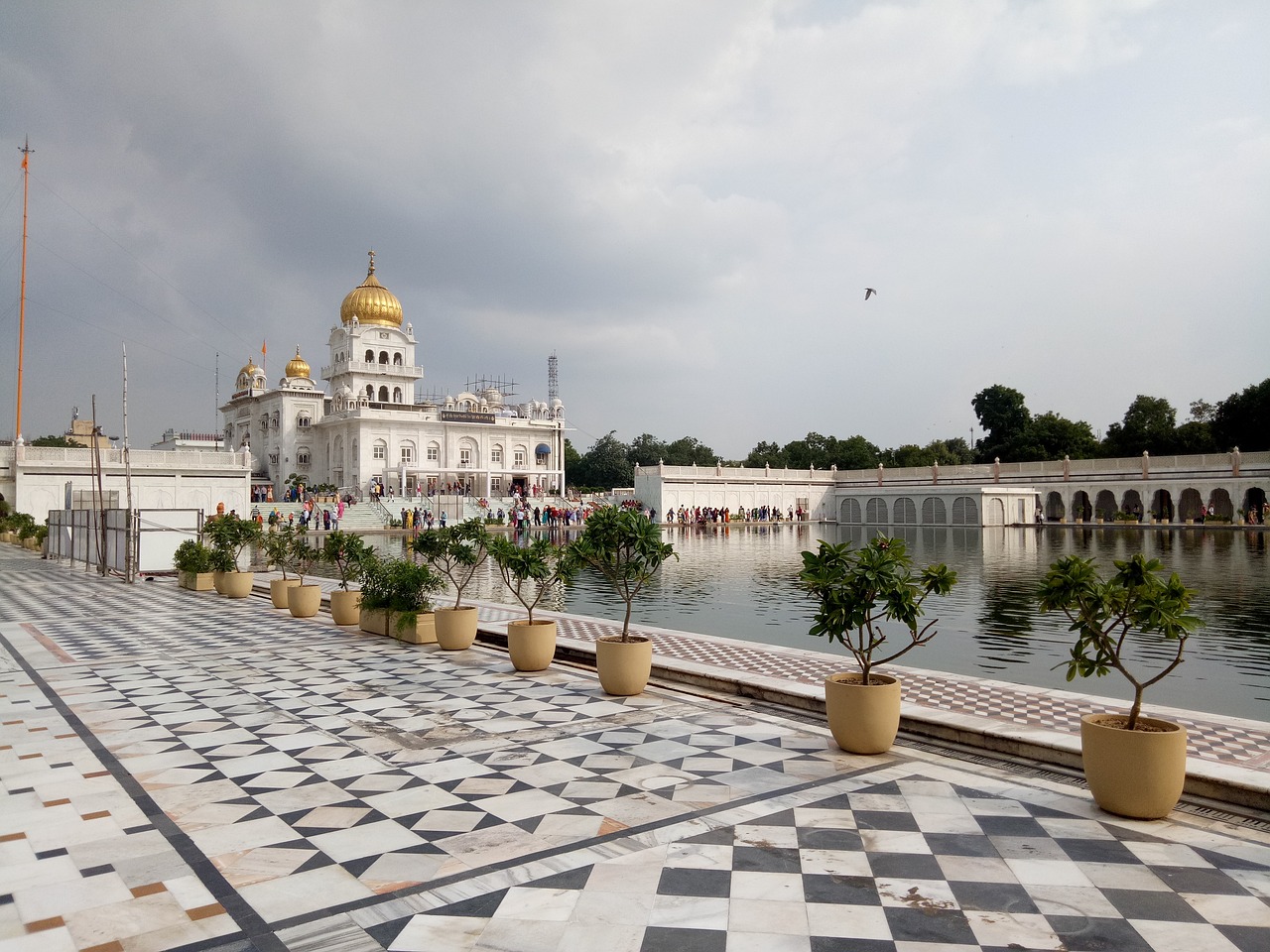
1. RED FORT
In the center of Delhi, India, stands the historic Red Fort (Lal Qila). From the middle of the 17th century until the British colonial era, it was the primary home of the Mughal emperors for almost 200 years. One of India’s most well-known structures, the fort is a quintessential representation of Mughal architecture. The fort is renowned for its opulent Mughal architecture, which combines Timurid, Indian, and Persian design elements. Its distinctive color comes from the red sandstone that makes up the majority of its composition. With elaborate carvings and inlaid patterns, the fort has stunning gates, gardens, places of worship, and halls.
-
- UNESCO World Heritage Site: Because of its historical significance and stunning architecture, the Red Fort was named a UNESCO World Heritage Site in 2007.
- Republic Day Celebrations: India’s Republic Day celebrations on January 26 are renownedly linked to the Red Fort. The fort is a representation of India’s independence and democracy since the prime minister speaks to the country from its walls.
- The fort combines aspects of Timurid, Indian, and Persian design to create an example of Mughal architecture.
The roughly 254-acre red sandstone fort is surrounded by a wall that is 2.5 km long.
The Diwan-i-Aam (Hall of Public Audience), where the emperor would see regular people, is one of the fort’s notable buildings.
Nobility and trusted advisors would meet with the emperor in the Hall of Private Audience, or Diwan-i-Khas.
The emperor’s wife and family lived in the palaces of Mumtaz Mahal and Rang Mahal.
The final notable Mughal emperor, Aurangzeb, constructed the white marble mosque known as Moti Masjid. - Political and Cultural Importance
The Red Fort hosted numerous significant political and cultural gatherings in addition to being the location of the Mughal government’s seat.
When the British acquired control of the fort in 1857, it became a symbol of Indian resistance following the fall of the Mughal Empire. This uprising is sometimes referred to as the Indian Mutiny.
Every year on August 15, Independence Day, the Indian Prime Minister addresses the country from the fort’s Lahori Gate, demonstrating its continued political significance. - The Present Day
The Red Fort now attracts millions of tourists annually, making it one of Delhi’s top tourist destinations.
It is home to the Red Fort Museum, which features a variety of antiquities from India’s extensive colonial and Mughal history.
The fort provides information about India’s colonial and medieval past and is also included in the Delhi Heritage Walks.
2. INDIA GATE

Located in the center of New Delhi, India Gate is one of the country’s most recognizable landmarks. In memory of the Indian troops who lost their lives in World War I and other conflicts, this imposing archway was constructed. Key information on India Gate is as follows:Design: Sir Edwin Lutyens, a British architect, created India Gate. The Arc de Triomphe in Paris, France, served as its inspiration, but it had a distinctly Indian flair.Elevation: The gate is 42 meters (138 feet) high.Material: The sandstone used to construct the structure gives it a majestic appearance.
A famous landmark in New Delhi, India Gate honors the troops who gave their lives in defense of India. It stands for solidarity, selflessness,and the nation’s tenacity. India Gate is still a treasured aspect of India’s history because of its grandeur, historical significance, and continued participation in national festivities.
In 2019, a National War Memorial was opened directly behind the India Gate complex. This memorial pays tribute to the soldiers who lost their lives in all conflicts since 1947, including the wars in Kashmir, China, and Pakistan. It is intended to serve as a more thorough remembrance of all Indian warriors who have died defending the country. Cultural Influence
India Gate is now a popular tourist destination and a representation of patriotism. It is among India’s most visited monuments.
Because of its prominent location and symbolic significance, it has also evolved into a venue for public assemblies and protests over time.
Location and Environment
The Rajpath, a magnificent ceremonial promenade that runs from Raisina Hill—the location of the President’s House and Secretariat—to India Gate, is where India Gate is situated.
Locals and visitors alike frequent the area surrounding India Gate, particularly in the nights when it is exquisitely illuminated and people congregate for picnics or leisurely strolls.
It is close to a number of other significant landmarks, including as Parliament House, Rashtrapati Bhavan (President’s House), and the National War Memorial
3. HUMAYUN’S TOMB

With features that eventually impacted the Taj Mahal’s design, Humayun’s Tomb is a masterwork of Mughal architecture. With its central tomb encircled by an arcade and expansive, symmetrical gardens, the tomb is constructed in the Persian architectural style. Particularly on the central dome, one of the most noticeable aspects, the mix of white marble and red sandstone produces a dramatic visual contrast. The tomb is a prime example of early Mughal architecture, which is distinguished by its tasteful fusion of Ottoman, Persian, Indian, and Islamic architectural components. One important historical site in Delhi, India, is Humayun’s Tomb. It is of immense architectural and historical significance and is the mausoleum of Emperor Humayun, the second monarch of the Mughal Empire.Empress Bega Begum, Humayun’s wife, ordered the mausoleum in 1569, and it was finished in 1572.
-
- The second Mughal emperor, Humayun, reigned from 1530 until his passing in 1556. Although his reign was turbulent, he is credited with creating the framework for the Mughal Empire’s development and advancement.
-
- Humayun’s Tomb, which combines Persian garden and Mughal tomb style, is the first garden tomb on the Indian subcontinent and marks a significant turning point in the development of Mughal architecture.Important Details Regarding Humayun’s Tomb
Location: Delhi, India’s Nizamuddin East
Bega Begum, Humayun’s first wife, gave the commission.
Integrated: 1565–1570
Persian and Indian architectural styles were incorporated into Mughal architecture.
Mirak Mirza Ghiyas, the architect, and Sayyid Muhammad, his son
Significance: India’s first garden tomb
Later Mughal architecture was influenced by it, such as the Taj Mahal, which was named a UNESCO World Heritage Site in 1993.
- Humayun’s Tomb, which combines Persian garden and Mughal tomb style, is the first garden tomb on the Indian subcontinent and marks a significant turning point in the development of Mughal architecture.Important Details Regarding Humayun’s Tomb
UNESCO World Heritage Site:
-
- In 1993, Humayun’s Tomb was designated a UNESCO World Heritage Site, recognized for its architectural brilliance and its influence on later Mughal architectur.
- Nearby Points of Interest
The tomb of Isa Khan, a pre-Mughal construction
famed Sufi shrine Nizamuddin Dargah
Qila Purana (Old Fort)
4. LOTUS TEMPLE

he Lotus Temple, a Bahá’í House of Worship in Delhi, India, is renowned for its distinctive architecture inspired by lotus flowers. It is one of the city’s most well-known landmarks and a significant representation of the Bahá’í faith, which upholds the equality of all religions and encourages harmony and peace.
Importance:
-
- The Lotus Temple is a universal representation of harmony, religious tolerance, and peace. People from different ethnic and religious backgrounds come together to enjoy its beauty and spiritual importance, making it an architectural wonder.
-
- Being a Bahá’í House of Worship, it provides a place where people can gather in quiet and reflection, bridging religious divides and advancing universal principles like harmony, love, and peace.
The Lotus Temple is one of the most significant and beautiful modern landmarks in Delhi and one of the most visited buildings in the world
Architectural Design:
-
- The Lotus Temple is a universal representation of harmony, religious tolerance, and peace. People from different ethnic and religious backgrounds come together to enjoy its beauty and spiritual importance, making it an architectural wonder.
-
- Being a Bahá’í House of Worship, it provides a place where people can gather in quiet and reflection, bridging religious divides and advancing universal principles like harmony, love, and peace.27 white marble-clad petals are grouped in clusters to resemble the shape of a lotus flower, which served as the inspiration for the Lotus Temple’s design.
-
- The petals of the temple are designed to resemble a lotus in bloom, and the building itself is composed of marble and concrete.
5. BANGLA SAHIB

The Gurudwara In Delhi, India, Bangla Sahib is one of the most well-known Sikh gurdwaras, or houses of worship. For Sikhs and people of all religions, it has religious and historical significance, and it is close to Connaught Place, a central part of the city. Dedicated to Guru Har Krishan Ji, the eighth Sikh Guru, who is said to have stayed here during his 1664 visit to Delhi, the gurdwara
Architecture:
-
- The Gurudwara’s architecture An exquisite illustration of Sikh religious artwork is the Bangla Sahib. The gurdwara is visually remarkable due to its huge golden dome and blue and white marble façade.
-
- With elaborate wall art that portrays events from Sikh history, the main prayer area is roomy and calm.
-
- A Nishan Sahib, or Sikh flag, and a sizable prayer hall coated in granite with a stunning golden dome in the middle are features of the gurdwara complex.
Langar (Community Kitchen):
-
- The Langar, a free communal kitchen that provides meals to all guests regardless of their background or faith, is an important aspect of Sikh gurdwara tradition.
Importance:
-
- In addition to being a site of worship for Sikhs, Gurudwara Bangla Sahib is a representation of the teachings of Guru Har Krishan Ji, especially his emphasis on healing, service, and compassion.
-
- As a representation of the Sikh principles of seva (selfless service), simran (meditation), and sangat (community), the gurdwara draws visitors from many religions who seek spiritual comfort, introspection, and a sense of belonging.
-
- It is a well-known religious landmark in Delhi and a popular destination for Sikhs from around the globe.
6. QUTUB MINAR

The Qutub Minar is a tall minaret in South Delhi, India’s Mehrauli neighborhood. It is regarded as a representation of Delhi’s rich Mughal and medieval past and is among the most well-known and recognizable historical sites in India. An impressive example of Indo-Islamic Afghan architecture is the minaret.
History and Construction:
-
- The founder of the Delhi Sultanate, Qutb-ud-Din Aibak, built the Qutub Minar in 1193. In 1368, his successor Iltutmish finished it.
-
- The minaret was constructed to honor Qutb-ud-Din Aibak’s conquest of Rajput monarch Prithviraj Chauhan and the beginning of Muslim governance in India.
-
- Originally designed as a tower of victory, the Qutub Minar also functioned as a minaret for the Quwwat-ul-Islam Mosque, one of the first mosques constructed in India and located nearby.
Architectural Design:
-
- The Qutub Minar is the world’s highest brick minaret, at 73 meters (240 ft) tall and composed of red sandstone.
-
- Each of the minaret’s five separate stories is identified by a protruding balcony. In the fourteenth century, Firoz Shah Tughlaq, the Sultan of Delhi, added the top story.
UNESCO World Heritage Site:
-
- Because of its architectural genius and historical value, the Qutub Minar was named a UNESCO World Heritage Site in 1993. It is a tribute to the art and culture of the Delhi Sultanate and is among the most popular tourist destinations in Delhi.
Importance:
-
- Qutub Minar, which symbolizes the start of Muslim sovereignty in India and the blending of Indo-Islamic architecture, is a representation of Delhi’s history and architectural heritage.
-
- It is both an architectural wonder of its era and a representation of the historical and cultural transformations brought about by the Delhi Sultanate.
